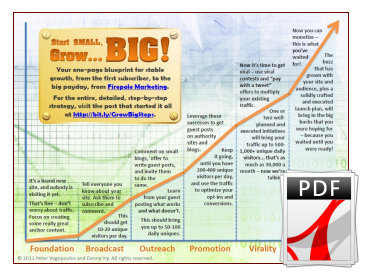Why Guru Strategies for Blog Growth DON’T WORK… and What Does!
 Blogging is where it’s at, right?
Blogging is where it’s at, right?
Whether you’re a professional blogger, or your blog is there to promote your regular business, you know that at the end of the day, your blog has one major purpose:
To engage a GINORMOUS audience.
That’s right. Not just big, but ginormous – an audience so large that you are guaranteed more customers than you know what to do with.
And yet, most blogs trudge along with an Alexa ranking north of a million, and you hear crickets more than you hear the pings of incoming traffic.
What’s going on?
You eventually reach the conclusion that you must be missing something. You go looking for help, and you’re bombarded with course offers and bombastic claims:
“Make $500 in one hour with our no-fail system!”
“Beat any competitor to Google’s first page in less than a week!”
“How I make $4,729.19 every week in my pyjamas!”
Sure, these claims raise an eyebrow, and at least a few questions. If it’s so easy to make $500 in an hour, then why are they selling it for $27, instead of just hiring people to do the work and make them the money? What if your competitor buys that same course – how fast will she knock you off of that top spot? And why do they always tell you the amount down to the last penny?
But as skeptical as you might be, you’re also hopeful. It seems like everyone but you is out there growing a giant site in no time. What’s their secret?
You shell out the cost of the programs, carefully ignoring the “results not typical” disclaimers. You sift through the nonsense, and find some good advice, which you diligently put to work. And then…
More crickets. What the hell?!
To Everything There Is a Season: Skyhooks and Cranes
Remember the phrase that goes “to everything there is a season”? The one that the Beatles copied from the book of Ecclesiastes? (Note: I’ve been advised that it was the Byrds, not the Beatles. Thanks Matthew Stillman!)
Well, the same applies to your blog’s growth (or anything, for that matter). You have to start at the beginning, and work your way up, one step at a time. Knockout strategies can work, but they require a foundation that a blog with minimal traffic just doesn’t have. When you try to skip steps, you fall down, and make no progress. I could write a book about the thousands of hours that I’ve invested this marketing blog. Trust me, it’s not easy.
One of the best explanations for this phenomenon comes from Dan Dennett – he introduced the concept of “skyhooks and cranes” in his book Darwin’s Dangerous Idea (he uses it to explain evolution by natural selection, but it applies very well here, too). Here’s how it works:
Let’s say that you want to build a building. In a perfect, imaginary world, you’d use a skyhook – a big hook in the sky to which you can attach a pulley system, to pull things off the ground. The only problem is that skyhooks don’t exist – there’s no way of making a hook just float in the air. From Wikipedia: “…the term “skyhook” describe[s] a source of design complexity that does not build on lower, simpler layers—in simple terms, a miracle.”
That’s exactly what bombastic internet marketing products are offering – to create massive growth that does not build on solid foundations. In simple terms, a miracle.
So skyhooks are out – does that mean we can’t build anything?
 Obviously, the answer is no.
Obviously, the answer is no.
To build our wondrous concrete jungles, we use cranes.
Cranes do exactly the same thing as skyhooks, only we build them from the ground up. Here’s the really interesting part: the way to build a giant crane that gives you lots of leverage is with smaller cranes!
So if you want to build something huge, you need to start with something small that you can use to get there.
The Tortoise and the Hare? Really?!
No, this isn’t a post about how you should be patient and take things slow and steady, because eventually you’ll win the race.
(As Sonia Simone said in a recent radio interview, “slow but steady works, but we’ve all had the experience of being beaten to the finish line by a jack rabbit with ADD!”)
The point of this post is that the fastest way to grow a blog is by using the strategy that fits with your current stage of growth. The more appropriate your strategy is to your stage of growth, the faster you’ll outgrow it, and be ready for the next one!
Here are the six steps:
Step 1 – Start with Great Content
Step 2 – Tell Everyone you Know
Step 3 – Start Building a Community
Step 4 – Promote Your Blog
Step 5 – Get Viral
Step 6 – Monetize!
Okay, let’s go one by one, and learn exactly what each step looks like, and what you need to do to “graduate” to the next one.
Crane Number One – All About Content
You’ve just finished building your blog – your theme is designed, widgets are installed, and a “welcome to my new blog” post graces the homepage.
It’s normal for you to be super-excited, and want to be out there, spreading the word.
Resist that urge!
Before telling anyone about your blog, you’ve got to make sure that there’s good content for them to read when they get there. That’s why your #1 priority with a new blog is to write some really great posts.
This is easier said than done – not only do you need to think of good stuff to write, but you’ve also got to stay motivated, even when your analytics are flat and you know that nobody is reading it. It’s hard, but it’s really worth it.
Crane Number Two – Telling Everyone
Once you’ve created great anchor content that will impress people who arrive at your blog, it’s time to spread the word – this starts with your nearest and dearest.
Reach out to everyone you know via email, Facebook, Twitter, the good old fashioned telephone, and any other way that you can think of. Tell them how excited you are about the new blog, and what your goals are for it. Ask them for feedback, and tell them how much it would mean to you if they subscribed, and would leave a comment on posts to let you know what they think. You can even ask them to help you spread the word, but don’t expect miracles.
This won’t give you tons of traffic, but it’s a start. Expect to get to about 10-20 unique visitors per day once you’re past the initial spike of people who come to look but don’t stay.
Crane Number Three – Community
Once you’ve got that baseline of traffic, and your nearest and dearest (particularly those in your blog’s target market) have given you some feedback, it’s time to broaden your circle.
Reach out to other bloggers in your community – but not the big ones, who have no reason to listen to you. I’m talking about the little ones – other blogs that are fairly new, and are getting less than 10-15 comments on their posts.
Find the good ones (it’s important that they actually be good), leave comments on their posts, and engage with them. Invite them to write a guest post on your blog – in most cases, they’ll be flattered, provide you with a great post, and tell all of their followers to go read it.
Of course, you should do the same for them. Share their good work with your network – the bloggers will thank you for the exposure, and your network will thank you for the good but obscure content that you’re sending their way.
You should also write guest posts for them, and respond to all of the comments that you get. Doing all of this will bring you up to the range of 50-100 unique visitors per day.
Oh, and pay careful attention to what resonates, because you’ll need it for the next step in the process.
Crane Number Four – Borrow Some Authority
Okay, let’s look at where we are; you’ve got great content on your site that your friends and family likes, and that has gotten good traffic and reviews from other members of your blogging community.
It’s time to take off the training wheels.
I’m talking about guest posting on the bigger blogs in your space. This is where you start tapping into bigger traffic numbers.
Here’s the short version of how to do it:
First, find the blogs that you want to guest post on. They have to be blogs whose audience would like your stuff, too. They should also be big enough to get you good traction; as a rule of thumb, say, an Alexa ranking of 100,000 or lower.
Second, read the blog, and figure out what you could write about that they will like, and to which they will respond well (respond well means that you’ll get lots of comments, tweets, and Facebook shares).
Third, if you haven’t already been active on the blog, read through it, and leave good comments on at least 2-3 posts. This is important – you have to get to know the style of the blog and blogger, and show them that you care.
Fourth, send the blogger an email. Keep it short and sweet, something like this:
I’m new on your blog, and I really like your stuff. [MAKE SURE YOU MEAN IT!]
I’ve been thinking about writing a post about [SUBJECT], and it occurred to me that it could be a great fit for your audience. What do you think of me writing it as a guest post? A headline for this post might be [HEADLINE IDEA] (of course, that’s just a suggestion).
If you want to see samples of my writing, you can check out [YOUR WEBSITE], or look at my last guest post on [SITE YOU GUEST POSTED ON] – it got [SOME MEASURE OF TRACTION].
What do you think? Shall I write up a draft?
If you do your homework and only pitch ideas that fit well with the blog, then most people will be happy to receive a draft. Once they say yes, send them the draft within a few days, and when it runs on the blog, be active and gracious in the comments.
Do this for a handful of blogs – until you get up to about 200-400 unique visitors per day.
In parallel with doing this, use your growing traffic numbers to optimize conversions – get your site to the point that your opt-in rates are good, and if you’ve got something to sell, people are buying with some regularity. Make sure everything is optimized before progressing to the next step in the process.
Crane Number Five – Let’s Get Viral
Once you’ve got over 200 unique visitors per day, you can kick it up a notch – it’s time for your traffic to get viral. In other words, you need to find ways of multiplying that traffic.
There are lots of ways to do this, and I’ll share two – but first, a warning. If your blog doesn’t have a good amount of traffic, and the process isn’t optimized, don’t skip ahead to this step!
This is important, because virality requires a critical mass. If you create an awesome piece of viral content and release it to your audience of seven readers, then sure, you might get lucky and someone might share it with someone who eventually shares it a lot… but that probably won’t happen. You have to make sure your content is getting enough exposure that when you produce something worthy of getting past the tipping point, it will be able to tip!
Okay, so let’s get practical – here are two ways that you can get viral (for more ideas, and more details about these ideas, you can read a whole post about viral marketing campaign ideas):
 Idea #1: Viral Content Contest – Run a series of posts about your subject, and make sure these posts are all share-worthy (read: really good). Then, add an incentive for sharing – run a contest, and enter people into a draw if they share. Does this sound familiar? It should, because this is exactly what we did with our FIRE-PROOF Selling series. Our blog was pretty new, and our hottest post before the series was getting less than 10 comments. The hottest post in the series got 35. ‘Nuff said.
Idea #1: Viral Content Contest – Run a series of posts about your subject, and make sure these posts are all share-worthy (read: really good). Then, add an incentive for sharing – run a contest, and enter people into a draw if they share. Does this sound familiar? It should, because this is exactly what we did with our FIRE-PROOF Selling series. Our blog was pretty new, and our hottest post before the series was getting less than 10 comments. The hottest post in the series got 35. ‘Nuff said.
Idea #2: Bonus for Sharing – Create an awesome piece of content, and give it away for free in exchange for sharing on Twitter or Facebook (you can do this with a free service like Cloud:flood or Pay With A Tweet). Innovative Thunder did this to launch their book called Oh My God What Happened And What Should I Do?, and got over 150,000 people to tweet about their book. Want to see how this works up close and personal?
This is where your traffic grows a lot – just a couple of these campaigns, properly executed, should bring you up to 500-1,000+ unique daily visitors… that’s as much as 30,000 a month – now we’re talking!
Crane Number Six – Cha-ching!
Most blogs falter because they’re busy trying to sell something when they should still be building an audience. Once you’ve got an audience that loves your stuff, selling is easy. This is the part where you can parlay your audience into big sales numbers.
I’m not going to go into all of the different ways that you can make money with a blog (selling a product, selling a service, selling advertising, affiliate products, speaking fees, etc.) – that’s beyond the scope of this post.
What I do want to stress, though, is that you should focus on building the audience first, and selling second. Too often, when people ask why their site isn’t making money, the answer is because nobody is visiting it. Growing your audience first, and selling after that, is how you solve that problem.
Going Off-Road? Take a Map!
Having shared these stages with you, am I saying that this is the one and only way to grow a blog, period? No, not really…
There’s lots that I haven’t covered, and there are many paths up the proverbial mountain. This isn’t the only path, or even the only good path. It is, however, a good path, a safe path, and a path that will get you there quicker than most of the others that I’ve seen – especially the ones that promise to teleport you to the top, but really just lead you off a cliff.
Here’s the beauty of this path – it works even if you veer off of it from time to time. And you will veer off from time to time; you’ll have ideas that you’ll want to try, or opportunities will present themselves that you won’t want to lose while waiting for the next step in the process.
No problem – veer off path, do what you’ve got to do, and if it works, so much the better.
But when you’re done exploring, work your way back to the path and pick up where you left off. To help you remember how it all works, we’ve put together a one-page PDF cheat sheet that we’re going to give you for free… well, almost free.
Remember the viral idea we talked about earlier? Paying with a share or tweet? Well, that’s what we’d like you to do. You see, we’re on this path, just like you are. So if you like what you’ve read, help us spread the word.
(Keep reading, there’s more…)
Oh, one more thing – please leave a comment! What do you think of this model? Do you see yourself on it? What stage are you at? What are you doing to get to the next one?
Danny Iny is an author, strategist, serial entrepreneur, and proud co-founder of Firepole Marketing, the program that teaches expert marketing for non-marketers.

Like what you read? Share it!
Disclosure: Some of the above may be affiliate links that I will be compensated for at no cost to you. They are products or services I’ve either used, vetted or trust. Enjoy!
WE THOUGHT YOU’D ALSO LIKE THESE POSTS

































